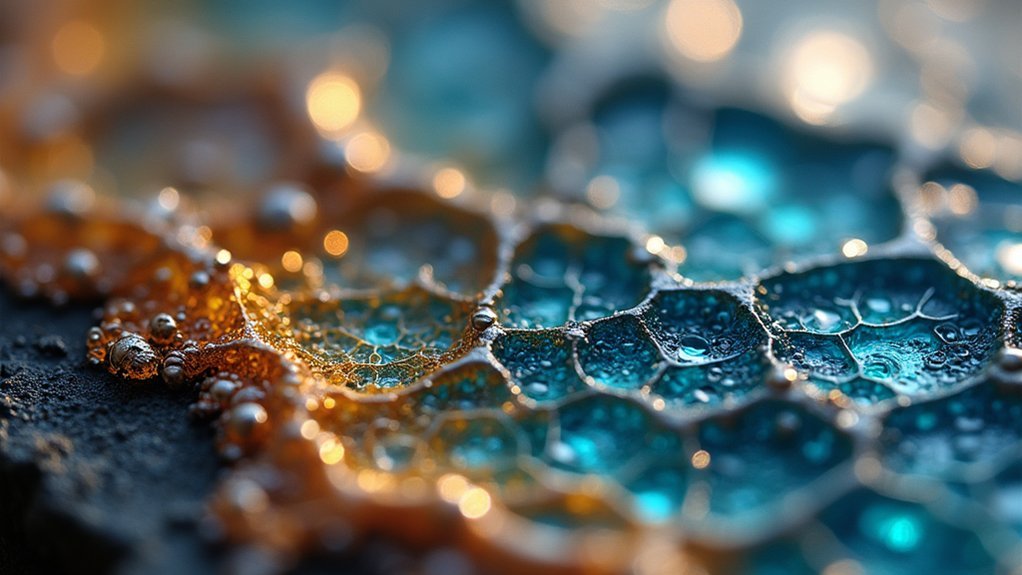High-quality petrographic images dramatically improve your mineral identification accuracy. Using proper camera settings—ISO 100, aperture f/9-f/13, and shutter speeds above 1/200—captures the subtle textures and structures essential for analysis. Consistent color temperature helps differentiate similar minerals, while diffused lighting reveals vital boundaries. A tripod eliminates blur, and 70% photo overlap creates seamless mosaics. Master these techniques and you’ll build a professional digital archive that enhances your geological interpretation capabilities.
Enhancing Mineral Identification Through High-Quality Documentation

When examining rock samples under a microscope, the quality of your petrographic images directly impacts identification accuracy. Your digital cameras must capture the subtle textures and structures that distinguish similar minerals.
Adjusting camera settings appropriately guarantees that fine details remain visible in your documentation. Consistent color temperature settings are essential—they help you differentiate minerals that may appear similar under variable lighting conditions.
Manage your ISO setting carefully to balance clarity with noise reduction, particularly when photographing dark or transparent minerals.
Technical Considerations for Polarized Light Microscopy Imaging
Although mastering polarized light microscopy requires technical precision, you’ll capture considerably better petrographic images by controlling several critical variables.
Maintain consistent camera settings across all samples—your ISO, aperture, and shutter speed directly impact image clarity and mineral detail resolution.
Invest in a camera with excellent color consistency to accurately diagnose mineral compositions. You’ll need sufficient dynamic range to distinguish between opaque and transparent minerals in the same frame.
Don’t underestimate proper lighting—polarized light sources reveal critical mineral characteristics and textures that might otherwise remain hidden.
Always mount your camera on a tripod, especially when using slower shutter speeds, to eliminate blur and maintain sharp focus.
This stability guarantees the fine crystalline structures remain crisp and diagnostically valuable in your documentation.
Camera Settings Optimization for Petrographic Analysis

Precise camera configuration forms the backbone of high-quality petrographic imaging.
When capturing thin sections, switch to manual mode for consistent control over exposure parameters. Set your ISO to 100 to minimize noise and enhance clarity in your mineral samples.
Select an aperture between f/9 and f/13 to achieve ideal depth of field, ensuring your entire specimen remains in sharp focus. Maintain a shutter speed of at least 1/200 seconds to eliminate motion blur, particularly important when working with polarized light conditions that may rapidly change.
Don’t overlook white balance adjustments—they’re critical for accurate color representation of minerals. Incorrect white balance can lead to misidentification of key diagnostic features.
These refined settings will dramatically improve the scientific value of your petrographic documentation.
Image Capture Techniques for Accurate Texture Representation
Successful representation of mineral textures depends on methodical image capture techniques that preserve every diagnostic detail.
You’ll achieve sharp focus by maintaining consistent camera settings—use low ISO (100) and small aperture (f/9-13) to capture the intricate mineral relationships in your samples.
Always mount your camera on a tripod when shooting at slower shutter speeds to eliminate motion blur that can obscure critical textural features.
Camera stabilization is non-negotiable when capturing mineral textures—every tremor compromises your scientific documentation.
Employ diffused lighting to minimize reflections that might mask subtle mineral boundaries and textures.
When creating mosaic images, overlap consecutive photos by 70% to guarantee seamless integration.
Don’t overlook white balance—proper color calibration is essential for accurate mineral identification.
These techniques will transform your petrographic imaging from merely adequate to scientifically valuable documentation of geological samples.
Building Digital Archives of Petrographic Specimens

With your image capture techniques perfected, it’s time to organize these valuable petrographic images into a cohesive digital archive. Your high-quality images will serve as permanent records of specimens, enabling precise mineral identification and supporting geological studies.
Maintain consistent camera settings (low ISO, proper aperture) to guarantee color accuracy and textural detail across your digital archives. This consistency makes specimen comparison more reliable.
| Archive Element | Best Practice |
|---|---|
| Image Resolution | Minimum 5MP for detailed analysis |
| File Naming | Include sample ID and date |
| Metadata | Add mineral composition notes |
| Storage System | Use cloud backup with local copy |
| Access Protocols | Create permissions for research teams |
Frequently Asked Questions
What Is the Advantage of Having a Camera With a Higher Resolution?
A higher resolution camera lets you capture finer details, zoom without losing clarity, print larger images, improve dynamic range, and distinguish subtle color variations in your photos. It’s essential for detailed visual documentation.
What Is the Purpose of the Petrographic Microscope?
A petrographic microscope allows you to examine thin rock sections under polarized light. You’ll identify minerals, analyze compositions, and study rock structures—revealing geological formation details that aren’t visible to the naked eye.
In Summary
You’ll gain immense value from investing in quality petrographic imagery. With optimized camera settings, you’re creating precise visual records that enhance your mineral identification capabilities and preserve essential specimen data. You’re not just taking pictures—you’re building a valuable scientific archive that improves your analysis, facilitates collaboration, and elevates your research. In petrography, your camera isn’t just a tool—it’s a vital extension of your microscope.





Leave a Reply